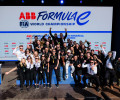Winning the race to engage new generations of enthusiasts

To racing purists words such as gaming, social media and fan activation might seem to have little to do with traditional motor sport but following yesterday afternoon’s plenary session on methods of making motor sport appealing to new generations of fans, such terms are likely to pass into the lexicon of motor sport organisers around the world.
Opening the discussion was Alex Trickett, Head of Sport at Twitter UK, who gave a presentation on how the fastgrowing world of social media can have a major impact on fans and participants alike.
He first detailed how social media has grown in recent years, with Twitter now home to 255 million active users and with more than 1 billion tweets being posted every two days. He added that 80 per cent of these were posted via mobile devices.
He then outlined how motor sport organisations can leverage social media in encouraging people to follow or participate in the sport.
Advocating that ASNs be brave in their use of social media he said that the environment provided a perfect
opportunity for organisers to break news, offering the example of English football club Manchester United, which revealed its signing of midfielder Juan Mata on Twitter. He added that the club had no presence on the platform a year ago but now has 2.6 million followers. He added that image-led posts are by far the most successful.
He went on to outline the value of social media as a promotional and brand -building tool before saying that in social media interaction it is important to be part of a conversation with fans, reacting and responding to their input to engender goodwill. Finally, he said that social media is a good tool for offering exclusive content to fans, granting them access to material and offers they would be unable to obtain elsewhere. Lorenz Beringer, former Head of Social Media at Bayern Munich then offered insights into how the world of football uses social media to talk to fans.
Delegates were also offered a case study in the shape of the new Bushy Park circuit in Barbados. Barbados Motoring Federation (BMF) President Andrew Mallalieu and Apex circuit design managing director Clive Bowen explained how the track, which was aided by the FIA’s Motor Sport Safety Development Fund, had been launched with a music festival that was wholly promoted via social media.
Former Ferrari team principal Stefano Domenicali then related his experiences with the team’s young driver development programme and the launch of the team’s online presence, before Darren Cox, the head of NISMO, Nissan’s racing arm, explained to the audience how the manufacturer had got involved in computer gaming to encourage youth involvement and to discover new talent.
He explained how the GT Academy, which began in 2008, utilises the Gran Turismo game, with which the FIA has just partnered, as a driver discovery/development tool.
One of the programme’s winners, Jann Mardenborough, was on hand to explain how his gaming pastime had led to a GT Academy place and this year to a drive with Arden International in the GP3 series.
Also representing young drivers were Ferrari development programme graduate Jules Bianchi, now racing for Marussia in Formula One, and Stoffel Vandoorne, who graduated from the FIA Institute’s Young Driver Excellence Academy and who is now a development driver with McLaren, racing in the GP2 series with Art Grand Prix.
The second half of the afternoon session was given over to a discussion of how to encourage new competitors by making racing affordable.
FIA Single-Seater Commission President Gerhard Berger explained how the FIA is redefining the racing ladder, first through the reshaped Formula 3 European Championship and most recently with the Formula 4 Championship for young drivers making an affordable step up to single-seater racing from karting.
Nicolas Deschaux, President of France’s FFSA, gave a presentation on the success of the ASN’s karting academies and afterwards, responding to a question submitted via the FIA’s Twitter feed, he offered advice to a group attempting to set up a motor sport academy in the Middle East.

Yoshiki Hiyama, Secretary General of the Motor Sports Department of Japan’s JAF highlighted the importance of drifting as a youth-participation discipline and explained how the ASN has set about regulating the emerging sport.
Michael Smith, from CAMS in Australia pointed to the success of its Motorkhana programme, in which participants are given a first taste of motor sport in their road car.

 Facebook
Facebook Twitter
Twitter






